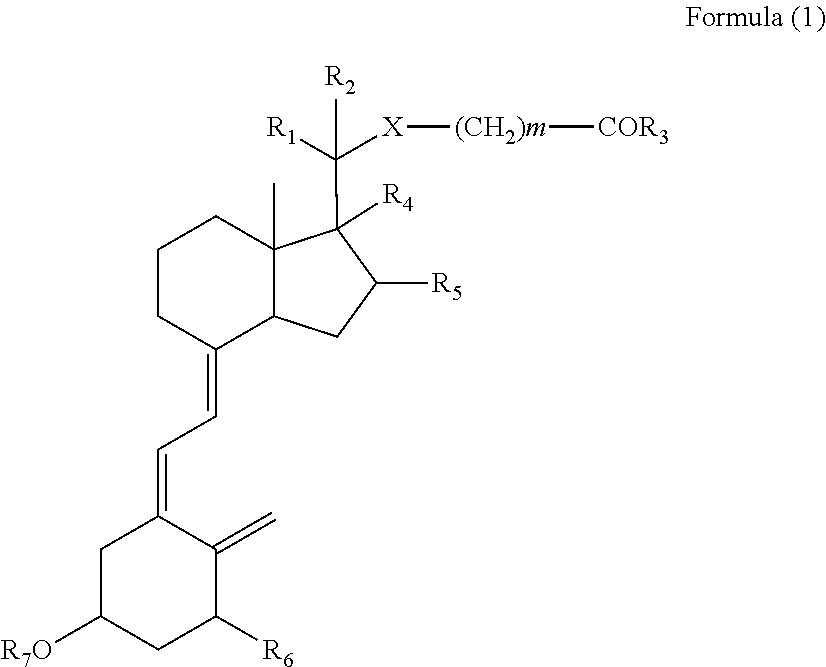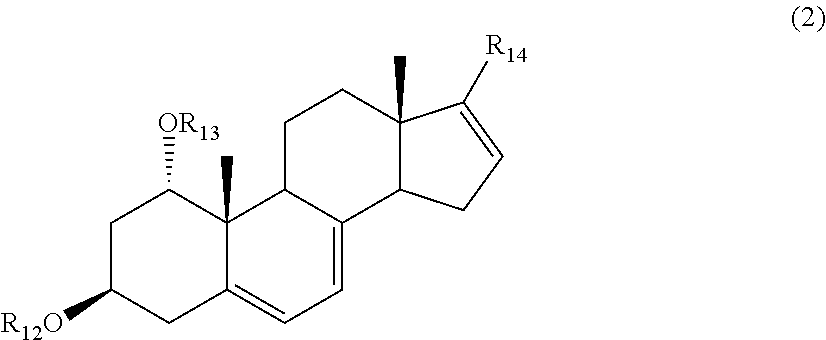Vitamin D derivatives
a technology of vitamin d and derivatives, applied in the field of vitamin d derivatives, to achieve the effect of reducing the hypercalcemic
- Summary
- Abstract
- Description
- Claims
- Application Information
AI Technical Summary
Benefits of technology
Problems solved by technology
Method used
Image
Examples
example 1
Preparation of 17-acetylthiomethyl-1α,3β-bis(tert-butyldimethylsilyloxy)androsta-5,7,16-triene
(1) Preparation of 1α,3β-bis(tert-butyldimethylsilyloxy)-17-(2,4,6-triisopropylbenzenesulfonylhydrazono)androsta-5,7-diene
[0202]1α,3β-Bis(tert-butyldimethylsilyloxy)-17-oxoandrosta-5,7-diene (1.64 g, 3.08 mmol) and 2,4,6-triisopropylbenzenesulfonylhydrazide (1.01 g, 3.39 mmol) were dissolved in ethyl acetate (6 ml) and stirred at room temperature for 16 hours. After evaporation under reduced pressure to remove the solvent, the resulting residue was purified by column chromatography (hexane:ethyl acetate=15:1) to give the titled compound (1.86 g, 75%).
[0203]1H NMR δ: 7.15 (s, 2H), 6.98 (brs, 1H), 5.58 (d, J=5.8 Hz, 1H), 5.40-5.33(m, 1H), 4.28-4.20(m, 2H), 4.18-3.93(m, 1H), 3.70-3.63(m, 1H), 2.95-2.74(m, 2H), 1.30-1.22(m, 24H), 0.88(s, 9H), 0.85(s, 9H), 0.68(s, 3H), 0.09(s, 3H), 0.06(s, 3H), 0.04(s, 3H), 0.03(s, 3H). IR(KBr): 3232, 2956, 2860, 1600, 1462, 1426, 1384, 1372, 1362, 1328, 1254, 1...
example 2
[0207]Steps (1) and (2) in Example 1 were replaced by the following Steps (1) and (2).
(1) Preparation of 1α,3β-bis(tert-butyldimethylsilyloxy)androsta-5,7-diene-(17S)-spiro-2′-oxirane
[0208]Sodium hydride (60% in oil, 0.2821 g, 7.06 mmol) was added to dimethyl sulfoxide (13 ml) and stirred at 80° C. for 1 hour. The resulting suspension was cooled to 0° C. and diluted with tetrahydrofuran (19 ml), to which a solution of trimethylsulfonium iodide (1.33 g, 6.50 mmol) in dimethyl sulfoxide (9 ml) was then added dropwise and stirred at 0° C. for 35 minutes. Subsequently, a solution of 1α,3β-bis(tert-butyldimethylsilyloxy)-17-oxoandrosta-5,7-diene (1.0 g, 1.88 mmol) in tetrahydrofuran (7 ml) was added and stirred at room temperature for 14 hours. The reaction mixture was poured into saturated aqueous ammonium chloride, extracted with ethyl acetate, washed with water and saturated aqueous sodium chloride, and then dried over anhydrous sodium sulfate. After evaporation under reduced pressure...
example 3
Preparation of 17-acetylthiomethyl-1α,3β-bis(tert-butyldimethylsilyloxy)androsta-5,7,16-triene
[0212]Steps (1) and (2) in Example 1 were followed by the step shown below instead of Step (3).
[0213]To a solution of 1α,3β-bis(tert-butyldimethylsilyloxy)-17-(hydroxymethyl)androsta-5,7,16-triene (100 mg, 0.183 mmol), triphenylphosphine (96.0 mg, 0.366 mmol) and imidazole (49.8 mg, 0.732 mmol) in dichloromethane (2 ml), N-bromosuccinimide (65.1 mg, 0.366 mmol) was added at 0° C. and stirred at room temperature. After 1 hour, hexane was added to the reaction mixture, which was then washed with water and saturated aqueous sodium chloride. After drying over anhydrous magnesium sulfate, the solvent was removed under reduced pressure to give a mixture (150 mg) containing 1α,3β-bis(tert-butyldimethylsilyloxy)-17-(bromomethyl)androsta-5,7,16-triene. This mixture was dissolved in acetone (1.5 ml), followed by addition of potassium thioacetate (31.4 mg, 0.275 mmol) and stirring for 30 minutes. The ...
PUM
 Login to View More
Login to View More Abstract
Description
Claims
Application Information
 Login to View More
Login to View More - R&D
- Intellectual Property
- Life Sciences
- Materials
- Tech Scout
- Unparalleled Data Quality
- Higher Quality Content
- 60% Fewer Hallucinations
Browse by: Latest US Patents, China's latest patents, Technical Efficacy Thesaurus, Application Domain, Technology Topic, Popular Technical Reports.
© 2025 PatSnap. All rights reserved.Legal|Privacy policy|Modern Slavery Act Transparency Statement|Sitemap|About US| Contact US: help@patsnap.com



